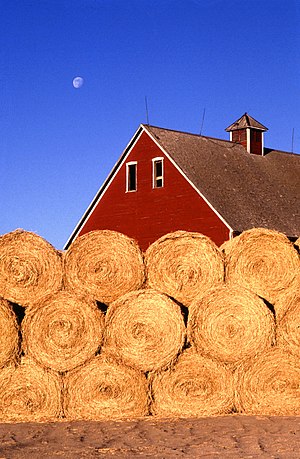1916-1917
Sold 4 sheep $35.30
" 1 cow 50.00
" 1 bull 60.00
" 1 " 25.00
" 1 horse $120.00
" 1 mule $125.
rec'd check for $115 and service
fees of colt $10 for balance.
Sold 4 sheep May 21, 1917 for
$102.95. Paid $20 on them
$ 20.00
$ 82.95 - due on sheep
$ 25.00 - paid May 31st 1917
$ 57.95
$ 35.00 paid June 17th 1917
Sold 2 hogs $50.40
Put 3 horses in Yorks pasture
May 2, 1926
2 horses in Hale's pasture
July 13, 1926
$10.50
[The pasture information above has a square around it, & the word "Paid" is written over the 2nd entry concerning the horses placed in Hale's pasture.]
" [July] 15 make hay (1/2 day Sim took hay home)
July 14 1 day both
June 14 1 da.
June 15 1 da.
July 11 1/2 " put hay rope on
July 12 1 " made hay (both)
July 13 3/4 " " " " "
took load home
Wow. Sounds like a lot of fun on the farm doesn't it? [Snort.] More like, a LOT of work.
 Image via WikipediaLooks like Sim helped out with the making of hay. There are a couple of references to "both" kinds of hay. Huh. Who knew there were different kinds of hay to be made? Makes sense now that I think about it. Different kinds of grass. Different kinds of hay. For all you ever wanted to know about hay and more, click here.
Image via WikipediaLooks like Sim helped out with the making of hay. There are a couple of references to "both" kinds of hay. Huh. Who knew there were different kinds of hay to be made? Makes sense now that I think about it. Different kinds of grass. Different kinds of hay. For all you ever wanted to know about hay and more, click here.  Image via WikipediaIn Google Books, I found on pp.853-854 of Iowa: Its History and Its Foremost Citizens, Volume 2 by Johnson Brigham that Iowa ranked first in hog farms, first in "proportion of land in farms", and second in value of crops in 1917. Additionally, Iowa was on top in total livestock in the early 1900s and "headed the long list of hay and forage states in 1909."
Image via WikipediaIn Google Books, I found on pp.853-854 of Iowa: Its History and Its Foremost Citizens, Volume 2 by Johnson Brigham that Iowa ranked first in hog farms, first in "proportion of land in farms", and second in value of crops in 1917. Additionally, Iowa was on top in total livestock in the early 1900s and "headed the long list of hay and forage states in 1909." |
| Old Heintz Barn courtesy of Donald Pointer. |
Now getting back to these other farmers' pastures. When you look at the map closely, you can find both the Hale farm and the Teed farm that she refers to. Notice how there's a water source on their land? However, this map doesn't show the marsh on Pointer land. And I do remember Great-Uncle Donald talking about a swimming hole. However, maybe it wasn't enough or perhaps the pasture wasn't enough or I don't know. [I didn't grow up on a farm.] But I love when I can find a map like this where I can "place" them in it, so to speak. Don't you?
~Caroline

No comments:
Post a Comment
Inappropriate comments will be deleted.